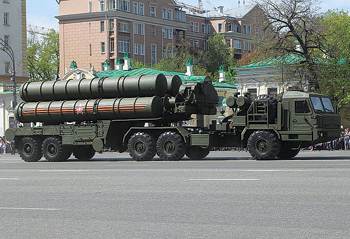INDIAN ARMED FORCES CHIEFS ON
OUR RELENTLESS AND FOCUSED PUBLISHING EFFORTS

SP Guide Publications puts forth a well compiled articulation of issues, pursuits and accomplishments of the Indian Army, over the years

I am confident that SP Guide Publications would continue to inform, inspire and influence.

My compliments to SP Guide Publications for informative and credible reportage on contemporary aerospace issues over the past six decades.
- Prime Minister witnesses 'Bharat Shakti' – a Tri-Services Firing and Manoeuvre Exercise in Pokhran, Rajasthan
- Interim Defence Budget 2024-25 — An Analysis
- Union Defence budget 2024
- Prime Minister Modi Commemorates Indian Navy Day in a Grand Ceremony
- Prime Minister Modi Flies in the LCA Tejas
- New Chapter in India-Italy Defence Ties
- Airpower beyond Boundaries
S-400 Triumf for India's air defence

India has cleared the acquisition of five S-400 Triumf air defence missile systems at a cost of Rs. 39,000 crore. The challenge now is how soon the deal can be inked, the systems inducted and integration into our air defence matrix.
Just before the December 2015 Moscow summit between Prime Minister Narendra Modi and Russian President Vladimir Putin, the Defence Acquisition Council (DAC) approved acquisition of five S-400 Triumf air defence missile systems ex Russia at a cost of Rs. 39,000 crore. The DAC approval, however, is just an acceptance of necessity (AoN) to be followed up through formal negotiations on the government-to-government deal with the Russians.
Referred as SA-21 Growler by NATO, the SA-400 Triumf can destroy incoming hostile aircraft, stealth fighters, missiles and drones at ranges of up to 400 km with a tracking range of 600 km and the ability to hit targets at a blistering speed of 17,000 km an hour – faster than any existing aircraft. The S-400 was developed to defend Russian air space and a few hundred kms further against missiles and aircraft of all types, including stealth. Because it is a highly potent and accurate weapon that can tip the balance of power in any war theatre, Moscow has long resisted the temptation of exporting even its older iteration, the S-300. When the S-400 deal is actually signed, it will among the largest-ever deals with Russia.
The other big deals inked with Russia include the over $12 billion deal 272 x Sukhoi-30MKI fighters, aircraft carrier INS Vikramaditya costing $2.33 billion plus 45 MiG-29Ks at a cost of $2 billion to operate from the deck of INS Vikramaditya.

The S-400 is an anti-aircraft weapon system developed by Russia in the 1990s as an upgrade to the S-300. It has been in service with Russian armed forces since year 2007, completion of the project having been announced in February 2004 and ballistic missile having been intercepted in a test of the upgraded 48N6DM interceptor missile during April of same year. The S-400 Triumf uses three different missiles to cover its entire performance envelope; the very long-range 40N6, long-range 48N6 and medium-range 9M96 missile. The S-400 utilises an active electronically scanned array. Only one system comprising up to eight battalions can control up to 72 launchers, with a maximum of 384 missiles. The missile is fired by a gas system from the launch tube and sent off more than 30 metres into the air before the rocket motor ignites which increases the maximum range, and decreases the minimum. All missiles are directed explosion warhead, increasing the chances of complete destruction of the target.
In November 2014, China had signed a deal with Russia to acquire six battalions of S-400 at a cost of $3 billion ostensibly for use against US and its allies in the Western Pacific. According to Paul Giarra, President, Global Strategies and Transformation, the S-400 will have the “effect of turning a defensive system into an offensive system, and extend China’s A2/AD (anti-access/area-denial) umbrella over the territory of American allies and the high seas.” Each S-400 battalion has eight launchers, a control centre, radar and 16 missiles available as reloads.
As per analysts, the S-400 defeats the US F-35 fighters. To counter the missile threat to its carriers, the Americans are relying on the F-35 as a cruise missile killer. More than a trillion dollars have already been spent on this troubled project. Even if the F-35 is able to miraculously overcome its shortcomings, the S-400 upends this strategy. On balance, the $500 million S-400 missile system is reported to be an effective counter to the brand new F-35 fighter making it almost obsolete despite being a trillion-dollar programme. According to ‘Air Power Australia’, “The S-300P/S-400 family of surface-to-air missile systems is without doubt the most capable SAM system in widespread use in the Asia-Pacific region.” In contrast, Lockheed Martin claims the F-35 has such advanced electronics that it can jam anything directed at it but the S-400 won’t be easy to shake off.
According to defence analyst Ivan Oelrich, the S-400 has many features specifically designed to overcome countermeasures and stealth, such as a larger, more powerful radar that is more resistant to jamming, besides it also actually has a set of three missiles of varying range that provide overlapping layers of defence.
As for India, now with the acquisition of the S-400 has been cleared, the challenge is how soon the deal can be inked, the systems inducted and deployed and above all their integration into our air defence matrix. Concurrently the air defence control and reporting system (ADC&RS) must also be speedily deployed.
The views expressed herein are the personal views of the author.





